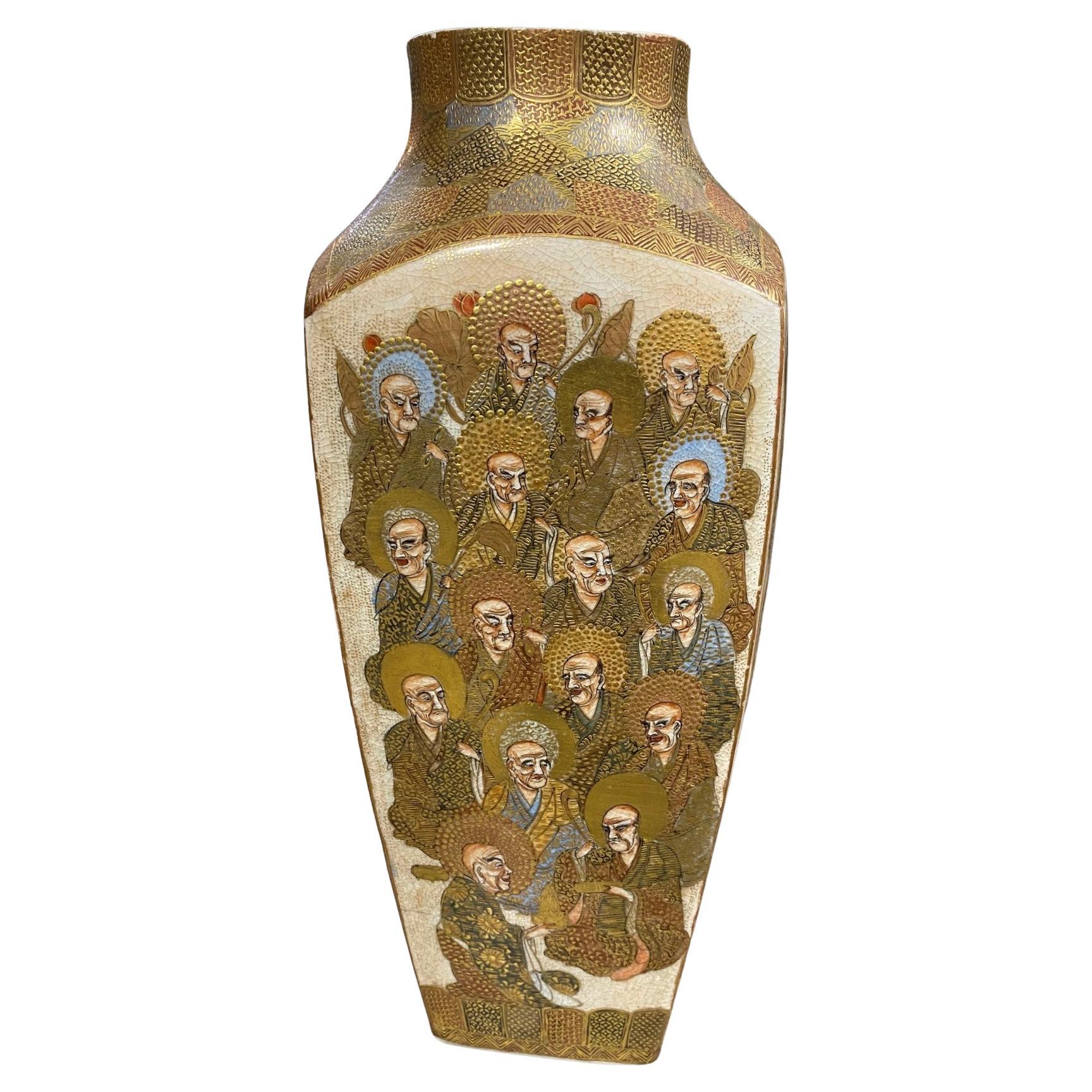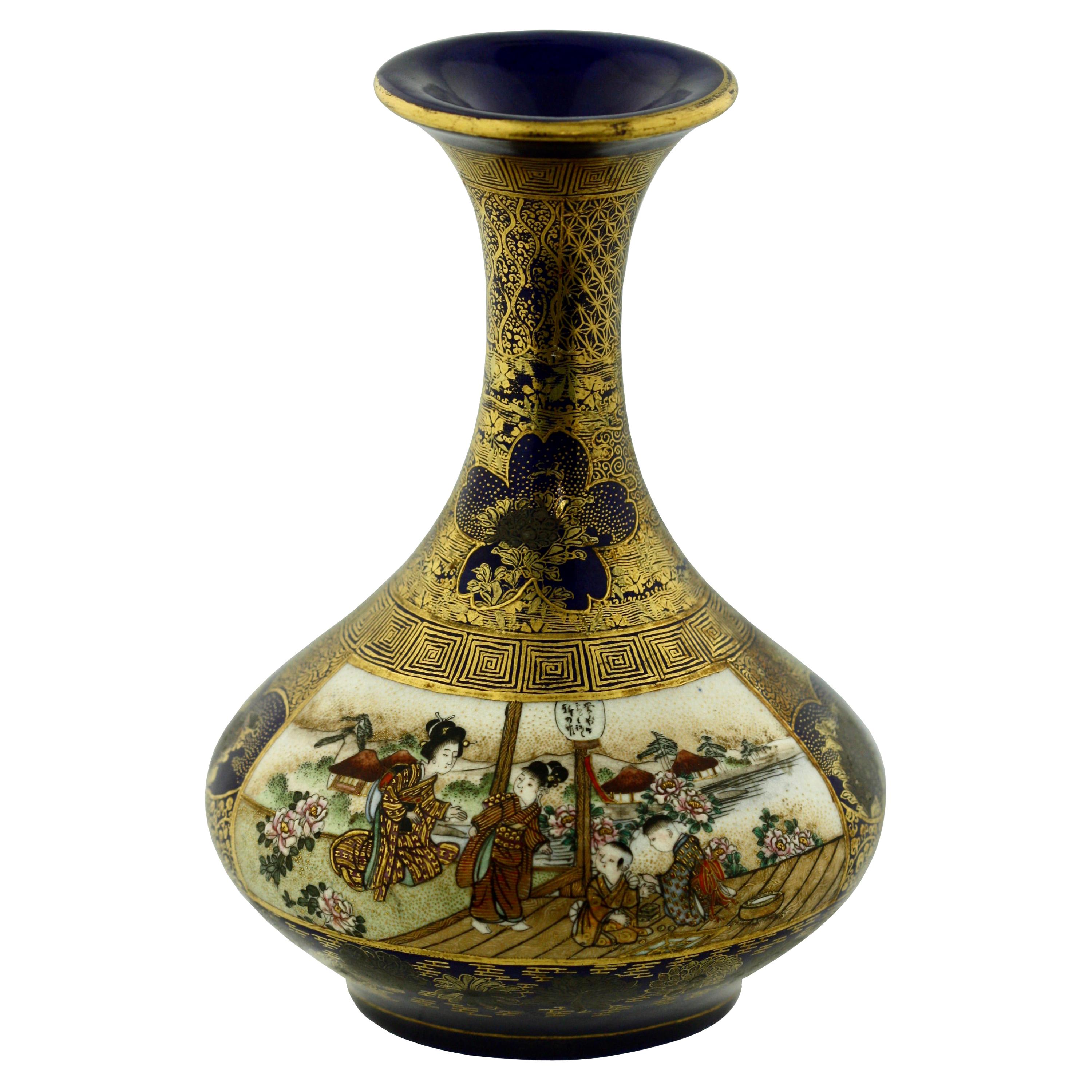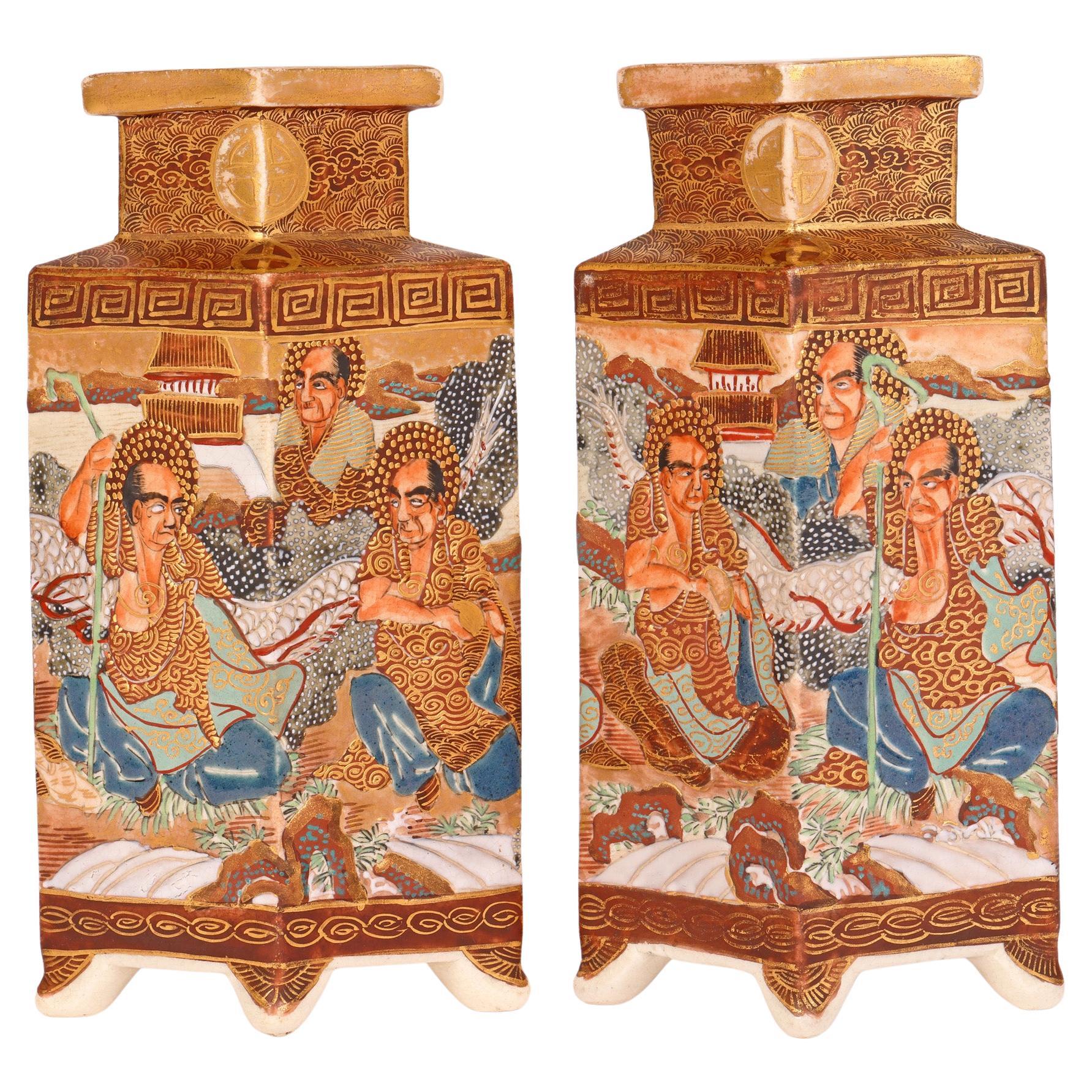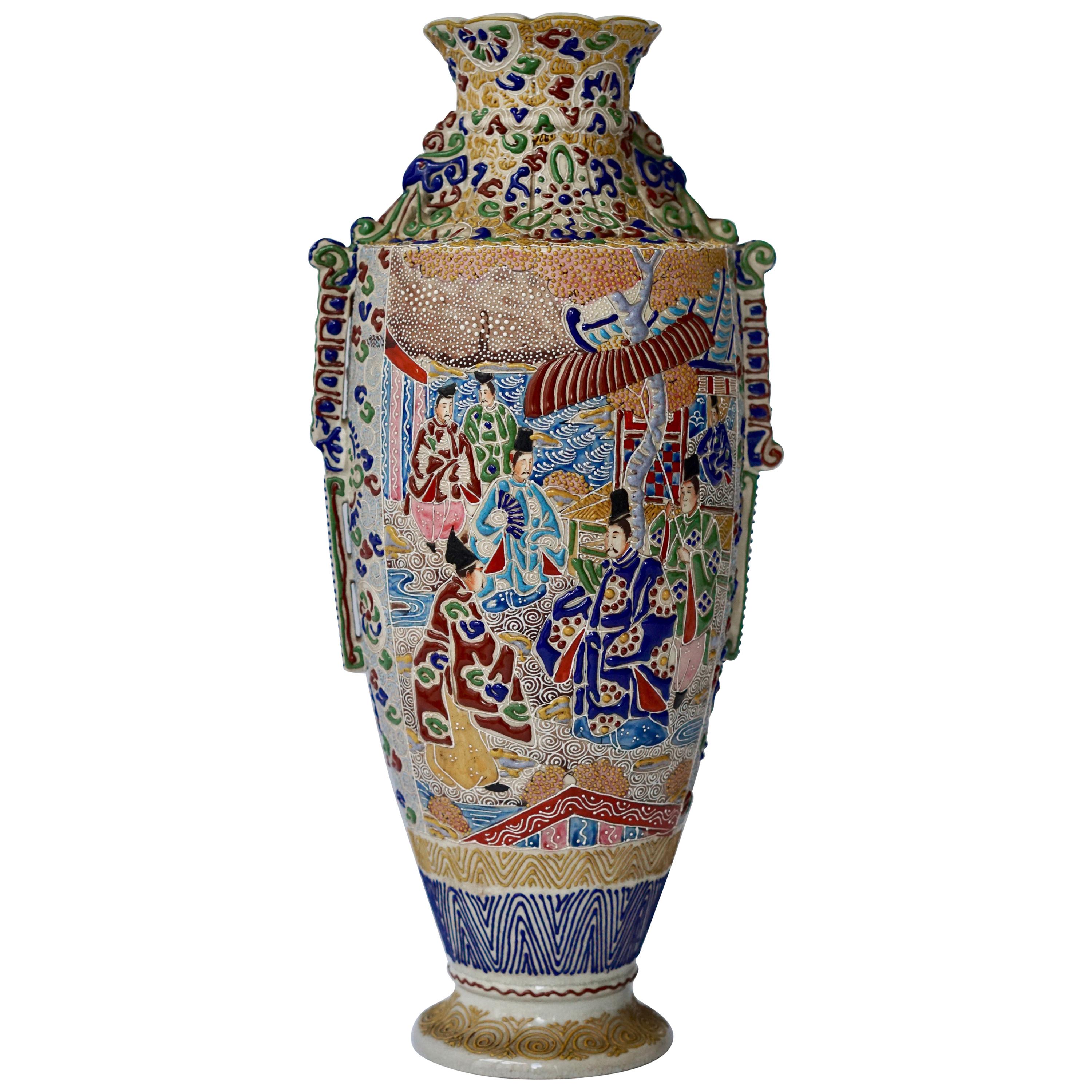Items Similar to Early Japanese Satsuma Antique Vase
Want more images or videos?
Request additional images or videos from the seller
1 of 15
Early Japanese Satsuma Antique Vase
About the Item
An Satsuma ceramic stone ware vase, circa 19th century, around the end of the Edo and the beginning of Meiji period. In the form of a Classic garlic bottle whose prototype was from China, the white bodied piece is decorated with an early form of kin nishikide, the so called golden brocade, a palette of iron-red, blue, green, yellow, purple and black with golden highlight. The over glazed enamel paint shows a group of robed figures in a garden setting with a lion and three tigers. A transparent overall glaze shows very fine crackles. The design is relatively sparse with plenty of negative space in contrast to the Satsuma production from the late 19th century, when the trend became fussy and overly glitz, due to the influence by the perceived western taste for the export market. This piece may still be made for export but its pattern was more influenced by both Kyoto Pottery and the Kano school of painting compared to the export ware by the end of the 19th century onward to the early 20th century. It was believed by many that this was a result of Satsuma potters visiting Kyoto in the late seventeenth century to learn over glaze painting techniques.
There are some age glaze crackles especially around the foot. The piece is not signed in keeping with the earlier production before Satsuma ceramics became ubiquitously signed with the Mon mark.
- Creator:Satsuma (Maker)
- Dimensions:Height: 12 in (30.48 cm)Diameter: 6 in (15.24 cm)
- Style:Japonisme (Of the Period)
- Materials and Techniques:
- Place of Origin:
- Period:
- Date of Manufacture:Mid-19th Century
- Condition:Wear consistent with age and use. Minor losses. Some age stable crackles, mostly around the foot rim. Minor spotty losses to enamel as shown.
- Seller Location:Atlanta, GA
- Reference Number:1stDibs: LU945015801752
About the Seller
5.0
Platinum Seller
These expertly vetted sellers are 1stDibs' most experienced sellers and are rated highest by our customers.
Established in 2006
1stDibs seller since 2010
478 sales on 1stDibs
Typical response time: <1 hour
- ShippingRetrieving quote...Ships From: Atlanta, GA
- Return PolicyA return for this item may be initiated within 2 days of delivery.
More From This SellerView All
- Exquisite Japanese Satsuma Vase by SeikozanLocated in Atlanta, GAA miniature vase in elegant upright form reminiscent of the Chinese imperial Willow Leaf form made by Japanese studio Seikozan circa 1890-1910s (late Meiji Period). One of the many a...Category
Antique 1880s Japanese Meiji Ceramics
MaterialsCeramic
- Large Japanese Satsuma Ceramic Vase KinkozanBy KinkozanLocated in Atlanta, GAA large Japanese ceramic vase from the end of Meiji period circa 1890-1910s by Kinkozan (1645-1927). One of the largest studio manufacturers of the export ceramics at the time based in Kyoto. In the typical style of satsuma made at the turn of 20th century, the vase is elaborately decorated with a rather unusual kinran-de (gold paint) and green enamel highlight on a mottled brown background. The painterly decoration depicts a large seasonal floral arrangement in a circular fashion. Besides the obviously superb craftsmanship, what sets this particular vase apart from many lower quality and mass-produced pieces is its tone-on-tone color pallet that is visually somber and the small and sensitive details that heralds the change of the seasons. When the viewer goes beyond the first casual glimpse of the blossom and foliage, one would notice that on the edges of certain leaves as well as along the stalks, there accumulates a very thin layer of the white dust that represents the frost. The flower in bloom are chrysanthemums. Despite of being splendid, they are the messengers of the autumn. The large lotus leaf was subtly rendered in a bended and slightly withered manner, just past its prime. Although the lotus is still in bloom, the prominent seed pod indicates it may be the last for the season. The sentimental capture of the change of the seasons is not unusual in Japanese art. This vase poetically represents such a subtle transition from summer to fall, perhaps depicting the very first frost. The neck of the vase is also slightly unusual with two rolled rings...Category
Early 20th Century Japanese Meiji Ceramics
MaterialsCeramic
- Japanese Satsuma Vase Yabu Meizan MeijiBy Yabu MeizanLocated in Atlanta, GAA Satsuma baluster form vase from the studio of Yabu Meizan (birth name Yabu Masashichi; 1853-1934), who is one of the most celebrated and collectible Satsuma artists from Meiji Peri...Category
Early 20th Century Japanese Meiji Ceramics
MaterialsCeramic
- Japanese Miniature Satsuma Vase Yabu Meizan MeijiBy Yabu MeizanLocated in Atlanta, GAA small Satsuma vase from the studio of Yabu Meizan (birth name Yabu Masashichi; 1853-1934), who is one of the most celebrated and collectible Satsu...Category
Antique Early 1900s Japanese Meiji Ceramics
MaterialsCeramic
- Fine Japanese Ceramic Satsuma Vase by KinkozanBy KinkozanLocated in Atlanta, GAA miniature Japanese ceramic vase from the end of Meiji period circa 1880s- 1910s by Kinkozan (1645-1927). One of the largest studio manufacturers of the export ceramics at the time ...Category
Early 20th Century Japanese Meiji Ceramics
MaterialsCeramic
- Fine Japanese Satsuma Vase with Superb Decoration by SeikozanLocated in Atlanta, GAA ceramic vase in tapered square form made by Japanese studio Seikozan circa 1890-1910s (late Meiji Period). One of the many artist studios that specialized in satsuma ware, Seikozan...Category
Antique 1880s Japanese Meiji Ceramics
MaterialsCeramic
You May Also Like
- Antique Japanese Meiji Satsuma Painted VaseBy SatsumaLocated in LA CIOTAT, FRA petite and beautiful hand-decorated ceramic baluster vase, painted all around with traditional Japanese motifs, including native flora, birds and bamboo stems on a creamy glazed background. The colour palette is bold and bright, with highlights of green, red and blue, together with plentiful gilt relief...Category
Antique 19th Century Japanese Meiji Ceramics
MaterialsCeramic
- Japanese Satsuma Vases, PairBy SatsumaLocated in New York, NYA gorgeous pair of Japanese earthenware Satsuma vases, hand-painted, Meiji period, circa early-20th century, Japan. Vases' beautiful decoration is high-qu...Category
Early 20th Century Japanese Meiji Ceramics
MaterialsEarthenware
- Japanese Antique Satsuma Pottery Buddhist Monks Vase with Shimazu Crest MarkBy SatsumaLocated in Studio City, CAA beautiful Japanese Satsuma pottery studio vase featuring multiple kesa-clad enlightened Buddhist monks on each side of the vase. The piece is finely detailed with rich raised gilt highlights throughout and beautifully decorated in gold and various hand painted other colors. From the Meiji period (1868-1912). This piece has the all-important Shimazu Family crest mark (red circle with a cross inside) on the base authenticating the work as an old and original Satsumaware work. The mark shows the pottery was made under the rule of the Shimazu clan. From a Los Angeles Collection...Category
Early 20th Century Japanese Meiji Ceramics
MaterialsEarthenware, Pottery
- Satsuma Earthenware Vase, by Kinkozan, Japanese, Meiji PeriodBy SatsumaLocated in West Palm Beach, FLA Satsuma Earthenware Vase, by Kinkozan, Japanese, Meiji period (1868-1912) decorated in polychrome enamels and gilt over a clear, crackled glaze, delicately painted with ladies and men, the reverse with a flowering garden with sprays of flowers, the neck with geometric and floral designs, a band of kifu heads in silver and gilt above the foot, on a midnight-blue ground, signed Kinkozan zo...Category
Antique 1860s Vases
MaterialsEarthenware
- Satsuma Japanese Meiji Pair Diamond Shaped Pottery VasesBy SatsumaLocated in Bishop's Stortford, HertfordshireA good and unusual pair antique Japanese Satsuma Meiji diamond shaped pottery vases decorated with monk figures with a scrolling dragon dating from the 1...Category
Antique 19th Century Japanese Meiji Ceramics
MaterialsPottery
- Japanese Satsuma Vase with FiguresLocated in Antwerp, BEA mid-20th century Japanese Satsuma vase with figures. Satsuma ware is a style of Japanese earthenware originally from the Satsuma region of what is today southern Kyushu. There are two distinct categories of this ware: The original plain dark clay early Satsuma...Category
Mid-20th Century Japanese Japonisme Vases
MaterialsCeramic
Recently Viewed
View AllMore Ways To Browse
Antiques Vase
Early Japanese
Early Japan
Japanese Antiques Furniture
Antiques Antique Vases
Stone Japan
Japanese Stone
Japanese Art And Antiques
Antique Art Ceramics
Antique Space Art
Japanese Mid Century Design
Antique Brown Ceramics
Japanese Midcentury Design
Japanese Mid Century Art
Midcentury Japanese Art
Ceramics From Japan
Antique Japanese Ceramics
Japanese Ceramics Antique





